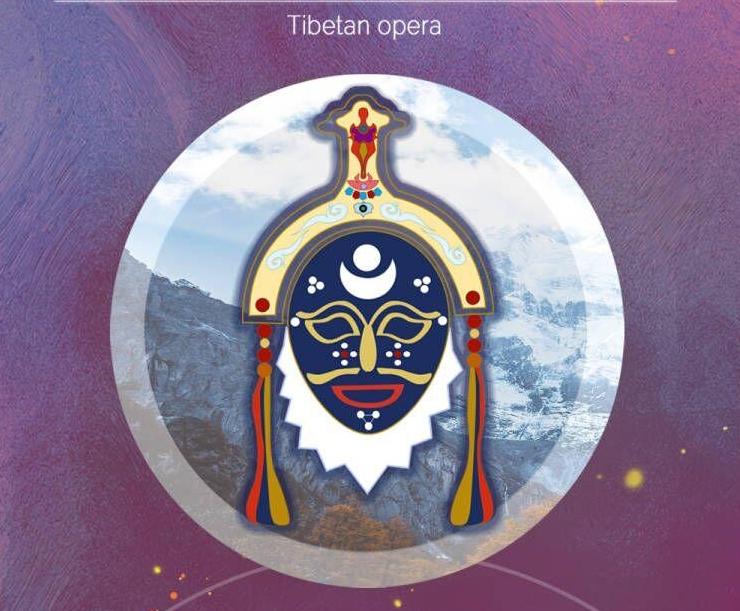
 0 Comment(s)
0 Comment(s) Print
Print E-mail China.org.cn, March 15, 2024
E-mail China.org.cn, March 15, 2024Editor's note: Tibetan opera is a form of performance art that is deeply embedded with traditional Tibetan culture. It is most popular in the Qinghai-Tibetan Plateau area in southwestern China. Combining acrobatics and chanting with other performing art forms, Tibetan opera was included on UNESCO's intangible cultural heritage list in 2009.

Tibetan opera, an ancient performing art, is highly representative of traditional Tibetan culture. It combines singing, dancing, chanting, acrobatics and religious elements. Performances' storylines cover everything from myths, legends and history to contemporary life events.
Tibetan opera is most popular in the Qinghai-Tibetan Plateau area in southwestern China. Thangtong Gyalpo, an eminent Tibetan Buddhist monk, is widely credited as its creator. He is deemed a great master of Tibetan opera.
A story about Thangtong Gyalpo's contribution to Tibetan opera is widely accepted among the Tibetan people. Born in the late 14th century (between 1361-1385), Thangtong Gyalpo was a man ahead of his time. He built 58 iron bridges for local people, several of which are still in use today. To fund these projects, he created a new style of live performance. Based on religious dance, this new performance style showcased myths, folk tales and Buddhist stories by integrating narration, dialogue, music and dance. Actors and actresses wore different masks to represent different characters and their individual traits. Thangtong Gyalpo's style of opera is widely considered as the origin of modern Tibetan opera.
However, some artists and historians trace Tibetan opera's roots even further back, to the early 7th century. In 641, Princess Wencheng of the Tang dynasty (618-907) married Tibetan King Songtsen Gampo. At the welcoming ceremony for the princess, performers sang and danced, wearing animal-skin or cloth masks that denoted basic elements of traditional Tibetan opera's customary costume.
In the 17th century, during the reign of the fifth Dalai Lama, Tibetan opera evolved into an independent dramatic form, shifting its focus from religious rituals to artistic expression. During this time, many professional troupes formed, different artistic genres emerged and a good number of classical repertoires were created. Large-scale Tibetan operas have been performed during Shoton Festival, a traditional Tibetan festival that is still celebrated to this day.
Today, Tibetan opera is also performed during other festivals, such as Ongkor Festival, Damar Festival and Tibetan New Year, attracting audiences from near and far. Actors wearing a variety of colorful costumes and painted masks narrate, sing or dance to display different roles. A red mask usually represents a king, green one for a queen and yellow one for a deity.
"Rooted in Buddhist teachings, the stories told in Tibetan opera recount the triumph of good and the punishment of evil and therefore serve a social teaching function for the community. This multifaceted representative of Tibetan art and cultural heritage also acts as a bridge among Tibetans in different parts of the country, promoting ethnic unity and pride," UNESCO has stated.
In 2006, Tibetan opera was included in the first group of national intangible cultural heritage (ICH) of China. Later in 2009, it was added to UNESCO's ICH list. Both professional and amateur artists have contributed to Tibetan opera's heritage.
Classic Tibetan operas, based on historic events and folk tales, such as "Princess Wencheng," "Prince Nor-bzang" and "Brothers Don-yod and Don-grub," are still among the most popular operas. Alongside preserving traditional elements of Tibetan opera, contemporary playwrights are also studying global artistic styles in order to enrich their own art form. In 2023, a Tibetan version of "Hamlet" was performed in Beijing, following a 2021 premiere in Shanghai. The script was translated by Nyima Dondrup, a nationally recognized playwright of Tibetan opera.
Discover more treasures from China on UNESCO's ICH list:
? 2022: Traditional tea processing
? 2020: Wangchuan ceremony, taijiquan
? 2018: Lum medicinal bathing of Sowa Rigpa
? 2016: Twenty-four solar terms
? 2013: Abacus-based Zhusuan
? 2012: Training plan for Fujian puppetry performers
? 2011: Shadow puppetry, Yimakan storytelling
? 2010: Peking opera, acupuncture and moxibustion, wooden movable-type printing, watertight-bulkhead technology of Chinese junks, Meshrep
? 2009: Yueju opera, Xi'an wind and percussion ensemble, traditional handicrafts of making Xuan paper, traditional firing techniques of Longquan celadon, Tibetan opera
